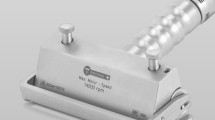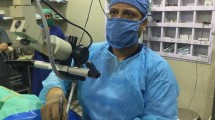Abstract
Cartilage-perichondrium composite graft is used in middle ear surgery for tympanic membrane, ossicular and for soft wall reconstruction. The thickness of the cartilage is thought to interfere with the sound conduction. In our otology practice for tympanic membrane reconstruction, we prefer the sliced cartilage graft to achieve acoustic benefit. At times in the process of slicing, the cartilage gets wasted if not sliced with a precision slicing instrument. We have designed and developed a multi-purpose cartilage slicer for precise reduction of the thickness of the cartilage. To describe the design of our cartilage slicer and to report our preliminary experience with the cartilage slicer. Descriptive study. The technique of slicing with our new cartilage slicer and its usage has been described in detail. A total number of 689 cartilages in tympanoplasty and mastoidectomy have been sliced with it from 2013 to 2017. Our study reports the technique of slicing the tragal cartilage for tympanoplasty, highlighting its advantages and precision of the cartilages slices obtained. Our cartilage slicer is a good option for cartilage slicing in tympanoplasty.
Level of Evidence
Level 4.





Similar content being viewed by others
References
Ben Gamra O, Mbarek C et al (2008) Cartilage graft in type I tympanoplasty: audiological otological outcome. Eur Arch Otorhinolaryngol 265:739–742
Dornhoffer JL (2006) Cartilage tympanoplasty. Otolaryngol Clin N Am 39:1161–1176
Loeb L (1926) Autotransplantation and homotransplantation of cartilage in the guinea pig. Am J Pathol 2:111–122
Kerr AG, Byrne JE, Smyth GD (1973) Cartilage homografts in the middle ear: a long-term histological study. J Laryngol Otol 87(12):1193–1200
Murbe D, Zahnert T, Bornitz M, Huttenbrink KB (2002) Acoustic properties of different cartilage reconstruction techniques of the tympanic membrane. Laryngoscope 112:1769–1776
Lee CF, Chen JH, Chou YF, Hsu LP, Chen PR, Liu TC (2007) Optimal graft thickness for different sizes of tympanic membrane perforation in cartilage myringoplasty: a finite element analysis. Laryngoscope 117:725–730
Bernal-Sprekelsen M, Romaguera Lilso MD, Sanz Gonzalo JJ (2003) Cartilage palisades in type III tympanoplasty: anatomic and functional long term results. Otol Neurotol 24:38–42
Uslu C, Tek A, Tatlipinar A et al (2010) Cartilage reinforcement tympanoplasty: otological and audiological results. Acta Otolaryngol 130:375–383
Yung M (2008) Cartilage tympanoplasty: literature review. J Laryngol Otol 122:663–672
Zahnert T, Huttenbrink KB, Murbe D, Bornitz M (2000) Experimental investigations of the use of cartilage in tympanic membrane reconstruction. Am J Otol 21:322–328
Dornhoffer JL (1997) Hearing results with cartilage tympanoplasty. Laryngoscope 107:1094–1099
Khan MM, Parab SR (2011) Primary cartilage tympanoplasty: our technique and results. Am J Otolaryngol 32(5):381–387
Khan MM, Parab SR (2013) Reinforcement of sliced tragal cartilage perichondrium composite graft with temporalis fascia in type I tympanoplasty: our techniques and results. J Rhinolaryngo.-Otologies 1:57–62. https://pdfs.semanticscholar.org/bf87/b72ac380b8f2d3bfd22fc56e6b3825c3e7ae.pdf
Khan MM, Parab SR (2012) Day care ear surgery: our experience of 4 years. Indian J Otolaryngol Head Neck Surgery 64(3):280–284
Khan MM, Parab SR (2014) Sliced island tragal cartilage perichondrial composite graft: early results and experience. J Rhinolaryngo-Otologies 2:4–9. https://pdfs.semanticscholar.org/99d9/f92402e6fe88186dd53c26e8e50e4282dcdc.pdf
Khan MM, Parab SR (2015) Comparative study of sliced tragal cartilage and temporalis fascia in type I tympanoplasty. J Laryngol Otol 129(1):16–22
Khan MM, Parab SR (2015) Average thickness of tragal cartilage for slicing techniques in tympanoplasty. J Laryngol Otol 129(05):435–439
Khan MM, Parab SR (2016) Novel concept of attaching endoscope holder to microscope for two handed endoscopic tympanoplasty. Indian J Otolaryngol Head Neck Surgery 68(2):230–240
Khan MM, Parab SR (2016) Endoscopic cartilage tympanoplasty: a two-handed technique using an endoscope holder. Laryngoscope 126:1893–1898
Parab SR, Khan MM (2018) Minimal invasive endoscopic ear surgery: a two handed technique Indian. J Otolaryngol Head Neck Surg. https://doi.org/10.1007/s12070-018-1411-7
Author information
Authors and Affiliations
Corresponding author
Ethics declarations
Conflict of interest
Application for IPR to the Government of India under the Design act in the name of Dr. Mubarak Khan. And “SLICE !t” is tradename secured for this. Dr Sapna Parab has helped in preparing the manuscript and evaluated the use of the Cartilage slicer actively during various cartilage tympanoplasties independently and along with second author.
Ethical Approval
All procedures performed in studies involving human participants were in accordance with the ethical standards of the institutional committee and with the 1964 helsinski declaration and its later amendments or comparable ethical standards Institutional Ethics Committee has approved the study.
Informed Consent
Informed consent was obtained from all individual participants included in the study.
Rights and permissions
About this article
Cite this article
Parab, S.R., Khan, M.M. New Cartilage Slicer for Slicing Techniques in Tympanoplasty: Design and Applications. Indian J Otolaryngol Head Neck Surg 70, 515–520 (2018). https://doi.org/10.1007/s12070-018-1467-4
Received:
Accepted:
Published:
Issue Date:
DOI: https://doi.org/10.1007/s12070-018-1467-4




